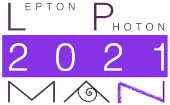Speaker
Description
The T2K experiment measures the neutrino oscillation parameters by observing $\nu_\mu$ ($\bar{\nu}_\mu$) disappearance and $\nu_e$ ($\bar{\nu}_e$) appearance from a $\nu_\mu$($\bar{\nu}_\mu$) beam. The events are observed in the near detector ND280 and the far detector Super--Kamiokande (SK) situated at 280 m and 295 km respectively from the beam production target. In SK, the products of $\nu$ and $\bar{\nu}$ interactions produce Cherenkov rings. Charged current quasi--elastic (CCQE) interactions, the most dominant in the T2K energy region produce single ring CC events used for analyses. Resonant 1$\pi$ production, the second dominant CC interaction in this energy region will have multi--ring topology and can be included to increase statistics. The addition of CC $\nu_\mu1\pi^+$ ($\nu_e1\pi^+$) samples are expected to improve the precision on $\sin^2\theta_{23}$ and $|\Delta{m^2}_{32}|$ (leptonic CP phase $\delta_{CP}$). Studies on the selection of CC $1\pi$ like events accumulated from forward horn current (FHC) operation are performed for $\nu_\mu$ and $\nu_e$ samples. Estimation of different systematic uncertainties are important for oscillation sensitivity studies. One main contribution is detector systematic uncertainities related to the selection variables of samples including multi--ring samples. These are estimated via a fit to atmospheric neutrinos events collected in Super-K. We present the selection of multi--ring samples as well as the process of estimation of detector systematic uncertainties.
